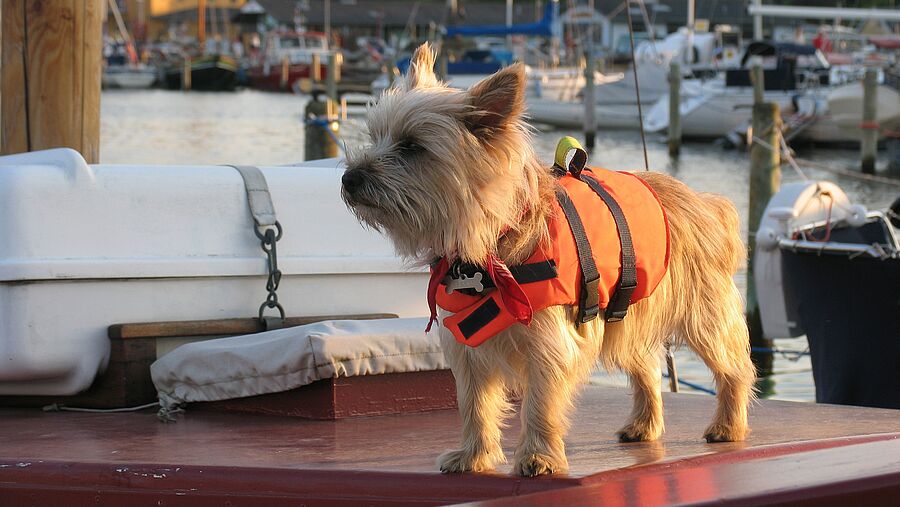
* Pantaenius UK Limited is authorised and regulated by the Financial Conduct Authority (Authorised No.308688)
Dogs and cats are often considered full family members, so why not take your furry roommates with you on the trip? With a little preparation, dogs, cats and other furry friends will quickly feel at home even the wobbliest of sailing yachts. Pantaenius shares their top tips for a successful cruise with animals:

The adventurer Liz Clark sailed with ‘Amelia, the Tropical Cat’ through the South Seas, on-board chicken ‘Monique’ reliably laid eggs every day for the French circumnavigator Guirec Soudée, and particularly famous is ‘unsinkable Sam’ the cat who, according to legend, survived the sinking of three ships during the Second World War.
Throughout history, animals have been regular seafarers aboard sailing boats; once to chase away rats, mice and thieves, and today, to keep their owners company. In order to make that first trip with your pet safe and relaxed for everyone involved, there are a few things to keep in mind:
When it comes to cats and dogs, as with humans, safety comes first. A dog or a cat sporting a life jacket is by no means a ridiculous idea! Both animal species are good swimmers by nature, but in the course of domestication this ability has all but disappeared from some breeds. Specially adapted lifejackets can be purchased from most large chandlers, or via the Internet. Ensure your pet tries the jacket on before you take to the water, the vest must fit perfectly! Pay attention to signal colours, reflector strips and sturdy webbing. A handle on the back of the vest will also make it easier to retrieve your pet from the water.
Anyone who owns a cat knows that these animals often hate restrictions of any kind. If your cat refuses to wear a vest, then we recommend attaching a special safety net to the sea fence and hanging a few pieces of rope over the side of the boat, so that the little tiger can quickly climb back on board if they should slip over the side.
Animals can also get sick or injured on board. When planning your trip, make a note of the addresses of any animal clinics that you can visit in case of emergency. Be sure to have an animal first aid kit aboard too for your little darling - your veterinarian will be able to help you put this together. If your trip takes you to other countries, you must also familiarise yourself with their vaccination and quarantine regulations.
Helping your pet find their sea legs
Animals need time to get used to new situations. Make it easier for them by allowing them to spend a little time aboard before leaving the berth. Let your animal discover the ship in peace, sniff, climb, doze... In this way, strange smells, noises and movements become familiar. When you can see that your animal is feeling at home, start the engine of your boat.
Always leash your pet beforehand to avoid chaos! If the sound of the engine has become familiar, you can venture on a first short ‘maiden voyage’ and gradually extend the time at sea until your pet is able to manage a longer tour with an overnight stay. If owner and pet still feel comfortable, nothing stands in your way!
Making the ship animal friendly
Before your first voyage, check your ship thoroughly for possible sources of danger. This includes pointed, sharp objects as well as poisonous cleaning agents and smooth surfaces on which your pet could slip. A shady spot is also very important, because thermoregulation in dogs and cats is done exclusively via the tongue and paws! Fresh water should always be available to your pet both in the harbour and whilst at sea. And it’s not only people who can have a hard time jumping from the jetty to the boat, add a ramp to help your dog or cat get aboard safely.
Of course, dogs are most fond of being close to their families; therefore, many on-board dogs feel most comfortable in the cockpit while sailing. Cats also like to slumber under the sprayhood. Like at home, however, animals also need a place on board where they can retreat. This is as close as possible to the centre of gravity of the ship, where the movements are least.
To prevent your cat from sharpening claws on the teak deck or your cushions, you should also take a small scratching tree with you.
When it comes to managing their business whilst sailing, cats are quite uncomplicated: Just take the litter box with you. With dogs it gets more difficult. Try a piece of artificial grass that has already been marked and scented by your animal.
Animals on shore leave
Cats are curious and love their freedom, so a stay in the harbour can be a great opportunity for stretching the legs and the sense. To prevent your pet from getting lost, it is essential that they wear a collar with your ship's name and telephone number on it, even if your pet is micro-chipped. Before you call into a port with your pet, inform the harbour master by radio. Hygiene or nature protection regulations may forbid your animal from disembarking.
Pantaenius wishes you lots of fun on your first trip with your dog or cat!